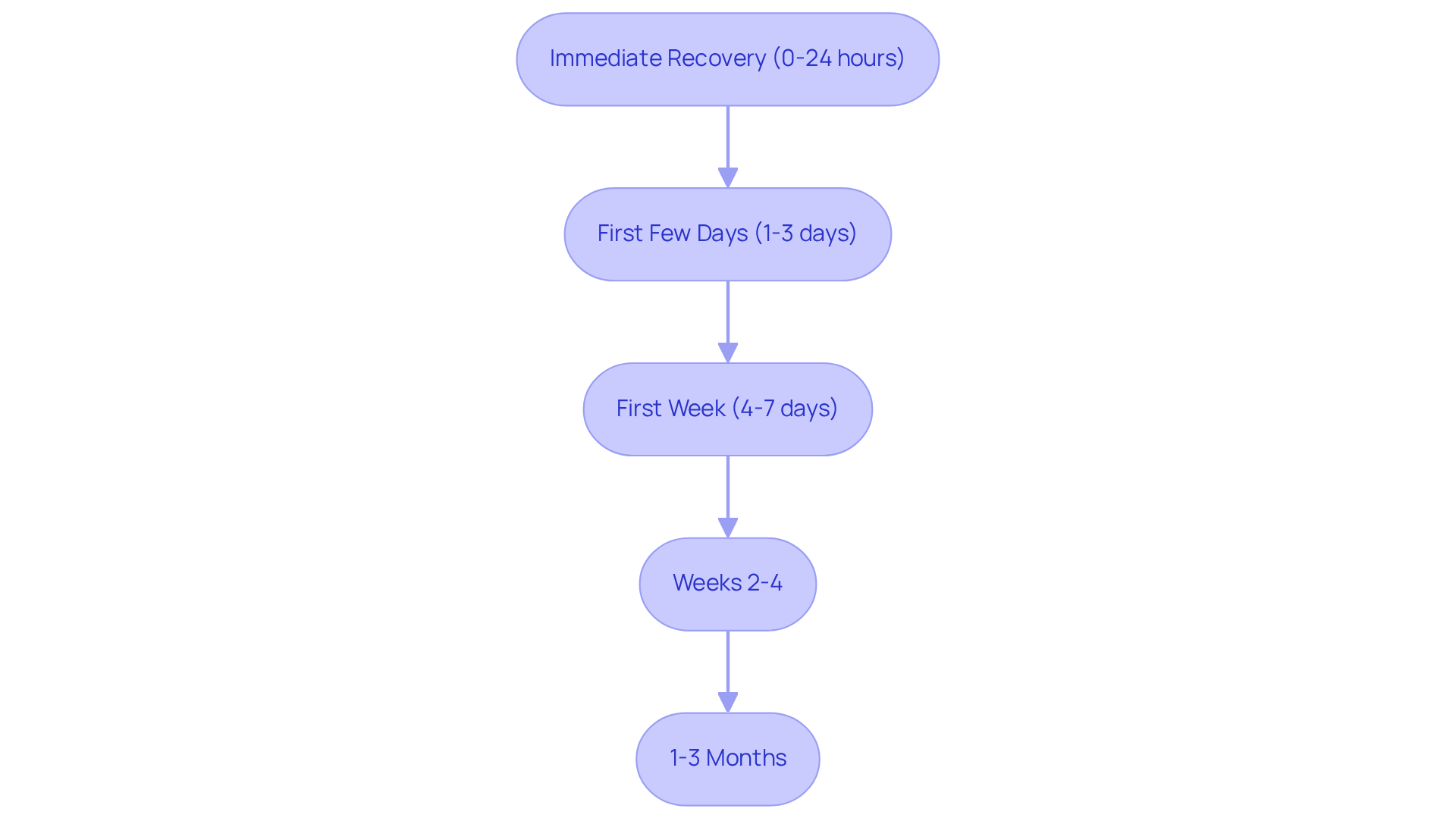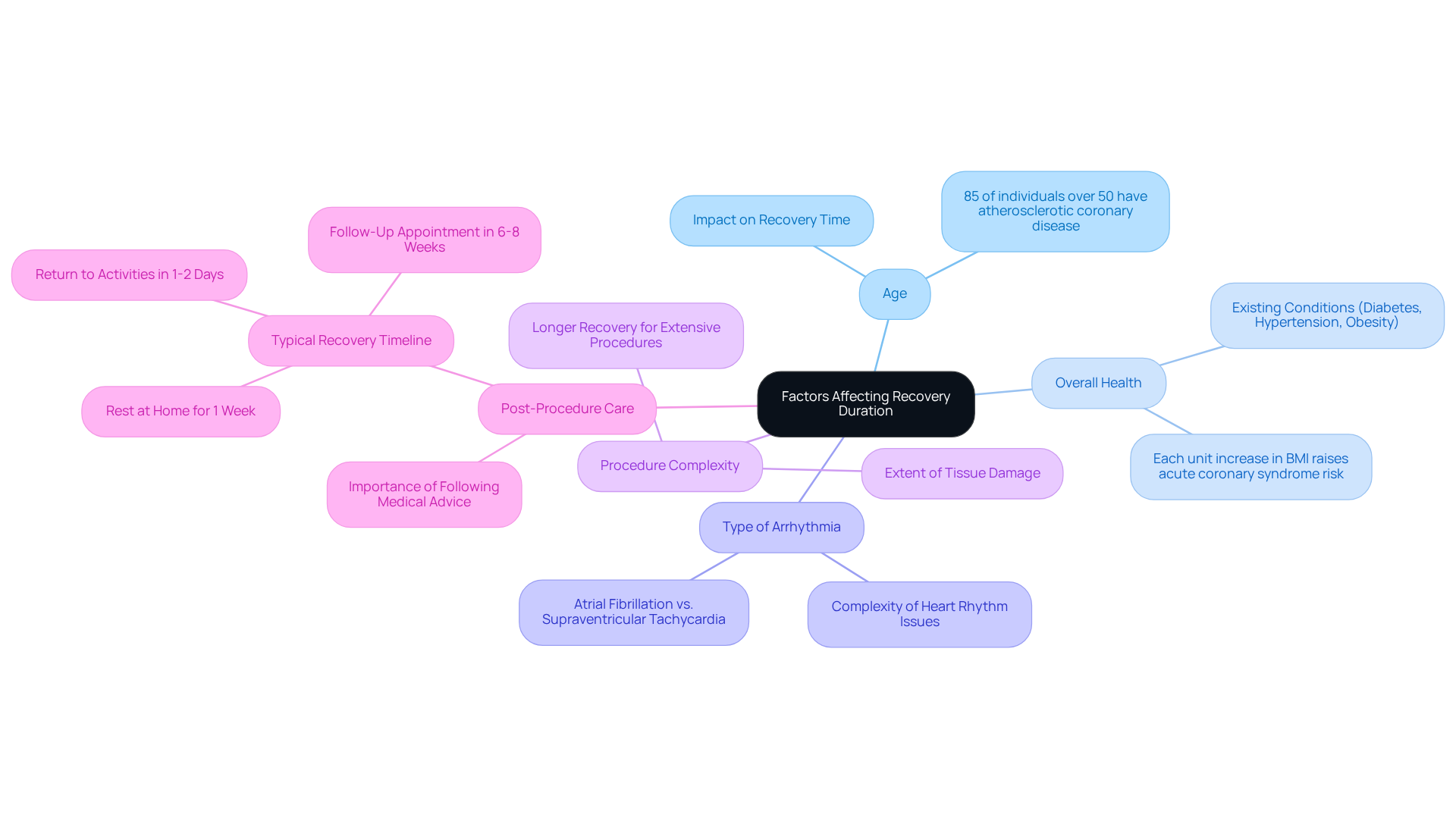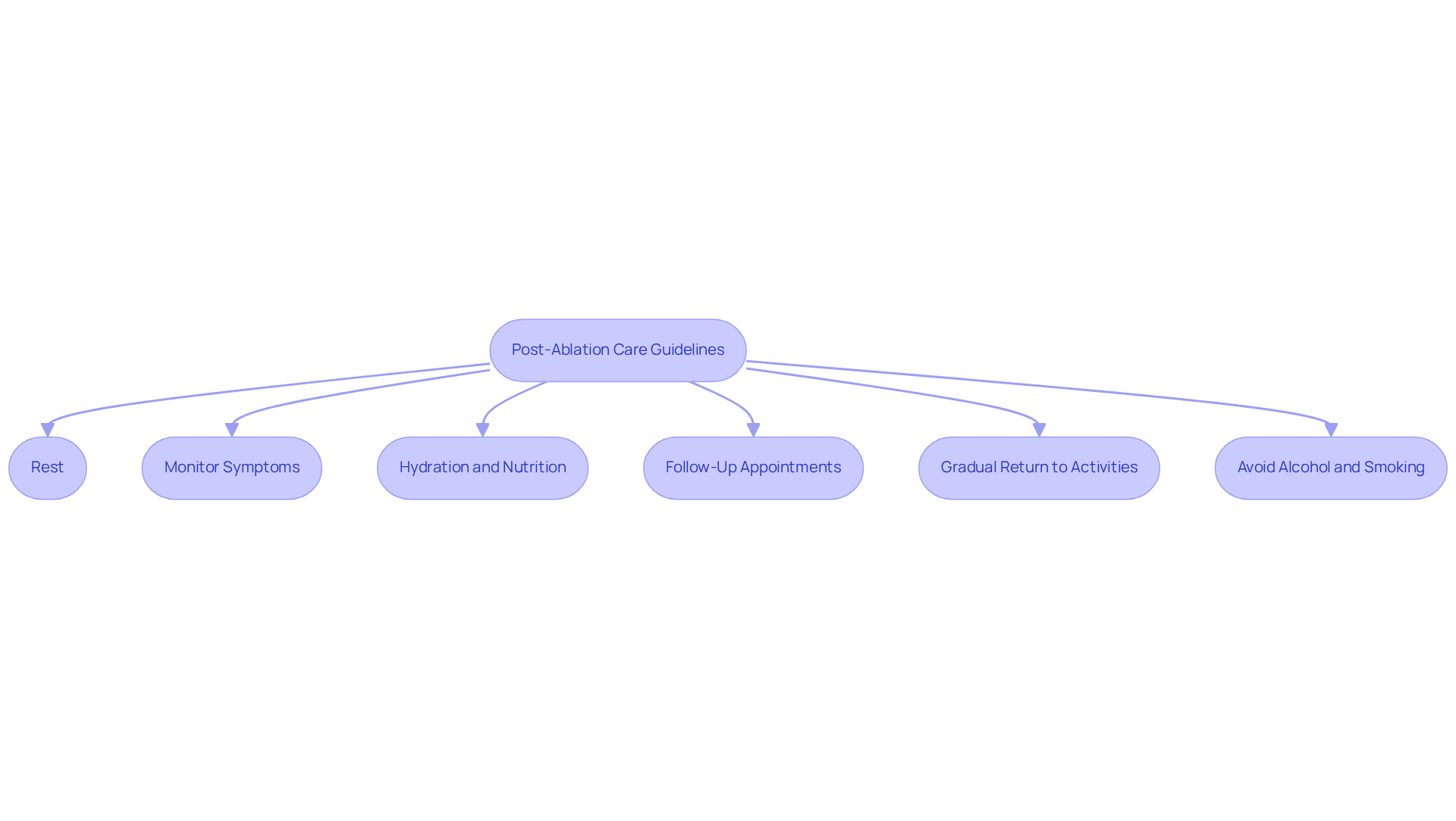


Understanding heart ablation can be a pivotal step for individuals grappling with irregular heartbeats. This innovative procedure offers a path to restoring normal rhythm and improving quality of life. However, it’s natural to feel uncertain about what comes next. Recovery time can vary significantly based on many factors, leaving many patients wondering what to expect.
How can you navigate the complexities of heart ablation recovery? It’s important to know that you’re not alone in this journey. This article delves into essential insights, recovery timelines, and care guidelines that empower you to take control of your healing process. By understanding what lies ahead, you can approach your recovery with confidence and clarity.
Heart ablation is a minimally invasive technique designed to help those experiencing irregular heartbeats, known as arrhythmias. By using heat or cold energy, this procedure creates small scars in the heart tissue that interrupt the faulty electrical signals causing these irregularities. This can restore a normal rhythm, offering hope to individuals who haven’t found relief through medication or who wish to avoid long-term drug therapy. It’s particularly effective for conditions like atrial fibrillation and supraventricular tachycardia, leading to significant improvements in quality of life by alleviating symptoms such as palpitations and fatigue.
At Amavita, we understand how crucial comprehensive cardiovascular management is, which is why we offer our CardioElite™ program. This program combines advanced AI technology with thorough staff training, providing healthcare providers with real-time diagnostic data and 24/7 cardiology consultation. This not only enhances proactive individual management but also helps reduce emergency workloads. Recent research shows that single procedures can alleviate atrial fibrillation symptoms in 70 to 80 percent of cases, highlighting its effectiveness. The CABANA trial, the largest clinical study comparing catheter treatment to drug therapy, revealed that individuals who underwent the procedure enjoyed improved quality of life and fewer hospitalizations. While the trial didn’t find a statistically significant decrease in serious adverse outcomes, those who had the procedure experienced lower rates of mortality and complications based on the actual treatment received.
Emerging techniques like pulsed field disruption (PFA) are paving the way for quicker procedures and enhanced safety compared to traditional methods. This progress reflects the ongoing advancements in the field, with cardiologists at Amavita emphasizing the importance of personalized treatment plans tailored to each individual’s unique circumstances, especially for those at higher risk. As the prevalence of atrial fibrillation continues to rise, with projections suggesting that cases in the U.S. may reach 12.1 million by 2030, heart procedures become an essential option for improving outcomes and promoting overall heart wellness.
If you or a loved one are facing heart health concerns, know that support is available. We’re here to help you navigate your options and find the best path forward.

The recovery timeline after heart ablation typically unfolds as follows:
Immediate Recovery (0-24 hours): After the procedure, you’ll be monitored in a recovery area for several hours. Most patients can go home the same day, but some may need to stay overnight. It’s important to remember not to drive for at least 48 hours after the ablation process.
First Few Days (1-3 days): You might feel some mild discomfort, bruising, or swelling at the catheter insertion site. Light activities, like walking, are encouraged to help you feel better. It’s also wise to avoid alcohol for at least 24 hours following the procedure. During this time, pay attention to any symptoms such as shortness of breath or fatigue, as these could indicate underlying heart valve issues.
First Week (4-7 days): Many patients return to their normal daily activities, but it’s best to avoid strenuous exercise and heavy lifting. Follow-up appointments are usually scheduled within this period to check on your recovery progress. Resting at home during this week can really help with healing. If you notice symptoms like breathlessness or swelling, please consult your healthcare provider, as these may be signs that need attention.
Weeks 2-4: You can gradually increase your activity levels, but still steer clear of high-impact exercises. Fatigue may linger as your body heals from the procedure. Thorough cardiac assessments can help identify any ongoing concerns related to arrhythmias or valve disease, ensuring you receive the necessary care.
1-3 Months: The heart ablation recovery time can require up to three months for complete healing. During this time, you may experience intermittent arrhythmias, often referred to as the 'blanking period.' This is a normal part of the healing process during the heart ablation recovery time as your heart adjusts to the changes made during the ablation. If you notice any swelling or redness at the puncture site, please seek medical attention, as these could indicate complications. Additionally, if general anesthesia was used, your healing time may be extended by up to 48 hours. At Amavita, we offer cutting-edge minimally invasive therapies for arrhythmias and valve disease, which can significantly enhance your healing results.
We encourage you to follow medical advice regarding activity levels to ensure a smooth healing process. Remember, you’re not alone in this journey; we’re here to support you every step of the way.

Several factors can significantly influence how long it takes to recover after heart ablation:
Age: If you're older, you might find that recovery takes a bit longer. This is often due to the body's natural healing processes slowing down. In fact, statistics show that about 85% of people over 50 years old deal with atherosclerotic coronary disease, which can make rehabilitation more challenging.
Overall Health: Your existing health conditions, like diabetes, hypertension, or obesity, can also affect how quickly you heal. For instance, each unit increase in body mass index raises the risk of acute coronary syndrome, highlighting the importance of managing these conditions before and after your procedure.
Type of Arrhythmia: The specific arrhythmia being treated can shape your recovery experience. For example, those with atrial fibrillation may face different challenges than those with supraventricular tachycardia. The complexity of your heart rhythm issue can influence how intricate the procedure is. At Amavita, we offer comprehensive arrhythmia management, featuring advanced therapies designed to restore your heart's natural rhythm, which can significantly impact your healing journey.
Procedure Complexity: The complexity of the ablation itself plays a role in how long it takes to heal. More extensive procedures often require longer recovery times due to greater tissue damage.
Post-Procedure Care: Following post-procedure care guidelines is essential for a smooth recovery. It's important to avoid heavy lifting and strenuous activities, especially in the first few weeks, to help your body heal. Sticking to medical advice can greatly influence your healing results. Cardiologists emphasize the importance of gradually returning to your daily activities. Typically, patients rest at home for about a week after the operation, and most can go home within 24 hours. A follow-up appointment is usually scheduled 6-8 weeks after the procedure to check on your progress and ensure everything is healing well. As Abby Sikorcin, MPAS, PA-C, wisely advises, "Be sure to follow the advice of your healthcare team, and don’t exert yourself too much in the first few weeks and months after the procedure."
Understanding these factors, along with the support provided by Amavita's CardioElite™ program, can help you set realistic expectations for your heart ablation recovery time during your healing journey.

Post-ablation care is crucial for ensuring a smooth heart ablation recovery time. You might be wondering how to best support your heart ablation recovery time. Here are some key guidelines to consider:
Many patients share how following these guidelines made a significant difference in their recovery. They often mention that those who adhered to their healthcare provider’s recommendations experienced smoother healing and better long-term outcomes. Healthcare providers also stress the importance of regular follow-up care, as it allows for timely adjustments to treatment plans and ensures any complications are addressed promptly.
You might find it comforting to know that mild chest discomfort and fatigue are common in the weeks following the procedure. These feelings usually resolve within 4 to 6 weeks. By prioritizing these aspects of your recovery, you can greatly enhance your chances of a successful outcome during the heart ablation recovery time. Remember, you’re not alone in this journey; support is always available.

Heart ablation is a crucial intervention for those facing arrhythmias, offering a chance to restore normal heart rhythms and enhance overall quality of life. It’s important for patients to understand the recovery timeline and the factors that can influence it. With the right knowledge and support, you can navigate your recovery journey with greater confidence and clarity.
Throughout this article, we’ve highlighted key insights into the recovery process. This includes:
Factors like age, overall health, and the complexity of the procedure significantly impact recovery duration, which is why personalized care plans are essential. Additionally, sticking to post-ablation guidelines-such as getting plenty of rest, staying hydrated, and attending follow-up appointments-can greatly enhance your healing outcomes.
Ultimately, the journey after heart ablation emphasizes the importance of informed decision-making and proactive health management. As heart conditions become more common, understanding the recovery process is increasingly vital. By prioritizing your health, following medical advice, and seeking support, you can significantly improve your recovery experience and pave the way for a healthier future. Remember, you’re not alone in this journey; support is always available.
What is heart ablation?
Heart ablation is a minimally invasive technique used to treat irregular heartbeats, known as arrhythmias, by creating small scars in the heart tissue to interrupt faulty electrical signals.
What is the purpose of heart ablation?
The purpose of heart ablation is to restore a normal heart rhythm for individuals who experience arrhythmias and have not found relief through medication or wish to avoid long-term drug therapy.
What conditions can heart ablation effectively treat?
Heart ablation is particularly effective for conditions such as atrial fibrillation and supraventricular tachycardia.
What are the potential benefits of heart ablation?
Benefits include significant improvements in quality of life, alleviation of symptoms such as palpitations and fatigue, and a reduction in the need for ongoing medication.
What is the CardioElite™ program offered by Amavita?
The CardioElite™ program combines advanced AI technology with comprehensive staff training to provide real-time diagnostic data and 24/7 cardiology consultation, enhancing proactive individual management and reducing emergency workloads.
What do recent studies indicate about the effectiveness of heart ablation?
Recent studies show that single procedures can alleviate atrial fibrillation symptoms in 70 to 80 percent of cases, indicating high effectiveness.
What findings were reported from the CABANA trial?
The CABANA trial found that individuals who underwent heart ablation experienced improved quality of life and fewer hospitalizations compared to those receiving drug therapy, although it did not find a statistically significant decrease in serious adverse outcomes.
What are emerging techniques in heart ablation?
Emerging techniques like pulsed field disruption (PFA) are being developed to provide quicker procedures and enhanced safety compared to traditional methods.
Why is personalized treatment important in heart ablation?
Personalized treatment plans are crucial as they cater to each individual's unique circumstances, especially for those at higher risk for heart conditions.
What is the projected prevalence of atrial fibrillation in the U.S. by 2030?
The prevalence of atrial fibrillation in the U.S. is projected to reach 12.1 million by 2030, highlighting the importance of heart procedures for improving outcomes and promoting heart wellness.